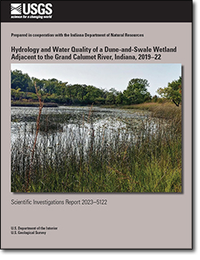Hydrology and Water Quality of a Dune-and-Swale Wetland Adjacent to the Grand Calumet River, Indiana, 2019–22
Links
- Document: Report (3.28 MB pdf) , HTML , XML
- Dataset: USGS National Water Information System database - USGS water data for the nation
- Download citation as: RIS | Dublin Core
Abstract
Adverse ecological and water-quality effects associated with industrial land-use changes are common for littoral wetlands connected to river mouth ecosystems in the Grand Calumet River-Indiana Harbor Canal Area of Concern. These effects can be exacerbated by recent high Lake Michigan water levels that are problematic for wetland restoration. Wetlands in the adjacent Clark and Pine Nature Preserve and Pine Station Nature Preserve are intended to mitigate wetland destruction in the area of concern by restoring residual dune-and-swale wetlands and preserving habitat for endangered and threatened plant species. Physical hydrology and water-quality monitoring of restored wetland cells at the preserves were initiated during 2019 to evaluate changes after wetland restoration efforts in 2015 and near record-low water levels in early 2013. Lake Michigan water levels rose steadily between late 2013 and 2018 to record-high water levels in 2019 and 2020. In this report, precipitation, evapotranspiration, and groundwater and surface-water levels are analyzed to better understand wetland inundation controls and flow directions in restored northern dune-and-swale wetland settings relative to the Grand Calumet River. Continuous specific conductance data and discrete water-quality samples were collected and analyzed to provide a synoptic view of water quality for the restored wetlands.
High Lake Michigan water levels affected Grand Calumet River stage and shallow groundwater elevations in the study area after the onset of peak lake levels in June 2019, that persisted through summer 2020, before finally receding in September 2020. Grand Calumet River stage peaked soon after lake levels in July 2019, whereas groundwater elevations in the study area peaked in October 2019. Specific conductance values in closed-basin wetland cells in the western and central parts of the nature preserves indicated a dilution trend and contrasted those of interconnected wetland cells along an eastern corridor, where alterations to wetland cells were more pronounced. Monitoring results indicate that varying seasonal wetland inundation trends with low stands in autumn have returned after high water table conditions owing to high water levels on Lake Michigan. Wetland water balance results during the study period indicated that the wetland ecosystem partially moderated flooding during high lake levels through summer evapotranspiration.
Suggested Citation
Naylor, S., and Gahala, A.M., 2024, Hydrology and water quality of a dune-and-swale wetland adjacent to the Grand Calumet River, Indiana, 2019–22: U.S. Geological Survey Scientific Investigations Report 2023–5122, 29 p., https://doi.org/10.3133/sir20235122.
ISSN: 2328-0328 (online)
Study Area
Table of Contents
- Acknowledgments
- Abstract
- Introduction
- Methods
- Results
- Groundwater-Flow Patterns and Interactions with Surface-Water Features
- Water Quality and Wetland Ecosystem Functions
- Summary
- References Cited
- Appendix 1. Groundwater-Elevation Data at the Clark and Pine Nature Preserve and the Pine Station Nature Preserve Near Gary, Indiana, in Fall 2019 and 2020
| Publication type | Report |
|---|---|
| Publication Subtype | USGS Numbered Series |
| Title | Hydrology and water quality of a dune-and-swale wetland adjacent to the Grand Calumet River, Indiana, 2019–22 |
| Series title | Scientific Investigations Report |
| Series number | 2023-5122 |
| DOI | 10.3133/sir20235122 |
| Publication Date | February 05, 2024 |
| Year Published | 2024 |
| Language | English |
| Publisher | U.S. Geological Survey |
| Publisher location | Reston, VA |
| Contributing office(s) | Ohio-Kentucky-Indiana Water Science Center |
| Description | Report: vii, 29 p.; Dataset |
| Country | United States |
| State | Indiana |
| Other Geospatial | Grand Calumet River-Indiana Harbor Canal Area of Concern |
| Online Only (Y/N) | Y |
| Additional Online Files (Y/N) | N |


